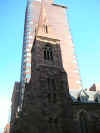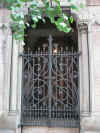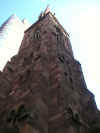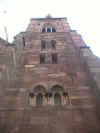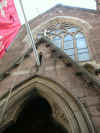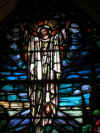| During the 19th
century, it was customary for Episcopal churches in New York to meet
their expenses with a system of pew rentals, rather than through
what has now become traditional weekly tithes. Certain pews were
kept open for visitors and those who could not afford a pew, but
some churches went a step further and built mission chapels where
pews were either free or rented for very small amounts.
In 1850, such a chapel was
established on Madison Avenue and 28th Street, as a mission of
Grace Church, a famous Greenwich Village house of worship, which
still stands on Broadway and 10th Street. Two years later, the
growing chapel became an independent chruch under the name of
The Church of the Incarnation. The Murray Hill area flourished,
and new space was soon required. However, the rector at that
time, the Rev. Dr. Henry Eglington Montgomery, refused to
consider a larger building until Incarnation had first founded a
mission chapel of its own. This was accomplished by 1863 on east
31st Street (today, The Church of the Good Shepherd), and land
was duly bought for the new church on 35th Street and Madison
Avenue.
Strong Bones, Healthy Body
The building, designed by Emlen T. Littell, laid its cornerstone
on March 8, 1864, and had its first services on December 11 of
the same year; it was consecrated on April 20, 1865.
Littell described the architecture
as "Early Decorated Church Gothic," with its opulent use of
gilding, color, stencilling and painted panels. Frequently
referred to as "Neo-Gothic," the architecture of the church is
historically based on the so-called English 19th century
Commissioners' style, named for the Commission of the Church
Building Society. This group built modest, attractive churches
for the many new communities in England created during the
industrial revolution. The churches feature a narthex, an open
nave with side aisles, and a short chancel; Gothic Revival style
added steeply pitched roofs, towers and a clerestory.
Builder Marc Eidlitz is also known
for the building of the former B. Altman department store,
across the street from Incarnation. Today, the building is
called the "B. Altman Office Superblock," and houses the
graduate school of the City University of New York, Oxford
University Press, and the Science, Industry and Business branch
of the New York Public Library.
Fire!
Our church was razed by a devastating fire in 1882, which
destroyed the entire east end of the church, and melted all the
stained glass. Left standing were only the western wall and the
tower.
David Jardine was commissioned to
oversee the rebuilding. Guided by Littell's original design, the
architect enlarged the building by increasing the length of the
nave and deepening the chancel. The building was reopened for
services at Christmas of 1882.
All the windows seen today were
completed and installed no more than a decade after the fire.
Depicting the religious narrative of cycles and events from
Christ's life in the New Testament, and with key figures and
events from the Old Testament, the windows are executed by
different artists from both sides of the Atlantic. Art scholars
and historians agree that this collection represents one of the
finest existing examples of glassmaking during one of the
craft's richest and most prolific periods.
Like a Phoenix, Reborn
After this point, there were few improvements made to the
building, among them a spire originally specified by Littel, but
added to the tower in 1896 by the architects Heins and LaFarge;
the Chapel of the Nativity, brought from England for
installation in the northeast corner of the nave, and dedicated
in 1903; and the small Chapel of the Resurrection, added to the
base of the tower in 1930. The original doorway into the tower
was filled in with a window depicting Christ's Ascension. There
appears to have been an additional otherwise unnoted renovation
done on the chancel some time after 1912, when a dated
photograph of the chancel featured a Latin cross between the
LaFarge murals, the walls painted blue and terracotta, and the
dome gilded. Visitors to Incarnation today will observe -- in
addition to the LaFarge mural and white marble altar -- a
central mural depicting six angels, an additional white reredos
above the original altar, and a whitened dome featuring three
clerestory stained-glass windows.
Ripples from the Stone Drop of Incarnation
Incarnation's influence on American and religious culture is
widely felt. Arthur Brooks, third rector, was instrumental in
the founding of Barnard College; he fervently believed in the
higher education of women, and served on Barnard's Board of
Directors for many years. His brother, fifth Bishop of
Massachusetts Phillips Brooks, is best remembered as the author
of the hymn O Little Town of Bethlehem. Admiral David
Glasgow Farragut is memorialized at Incarnation; his oft-quoted
battle cry, "Damn the torpedos! Full speed ahead!" is an
integral part of the English language.
During the first half of the 20th
century, many prominent New York families, the Delanos and
Morgans among them, were members of Incarnation's parish.
Incarnation's name decorates many wedding and baptismal
certificates of the wealthy, famous, and powerful, though such
events were normally held in private homes. Funerals were,
however, held at the Church. When Franklin Delano Roosevelt's
mother died, Incarnation built access ramps to allow the son to
attend her funeral.
Changes in Fortune -- and Growth
In the latter half of the century, Incarnation's fortunes changed;
just before mid-century, the rector recommended the church be
closed and the property sold. John Atherton Bell, who served the
parish for 32 years during this difficult time, managed to keep
Incarnation intact into the 1970s.
With the arrival of the current
rector, cost-cutting measures and concerted efforts at
fundraising were made, and Incarnation is currently enjoying a
surge in membership. In 1997, a record-number of baptisms were
held on a single day: on December 7, seven persons were
baptised, including infant triplets, two children, and two
adults. In 1998, the largest confirmation class in living memory
-- eight adults -- was presented to the Vicar Bishop, the Rev.
Don Taylor, for confirmation or reception to the Episcopal
Church.
Today, Incarnation is subtitled
"the Landmark Church of Murray Hill," and is one of New York's
Historical Landmarks, with major restoration work completed in
1992. A recent guidebook notes that Incarnation "contains some
of the finest ecclesiastical artwork in America." Any member of
the Incarnation parish will also tell you that it's one of the
friendliest, warmest places to be. The services are beautiful,
the art and light in the building inspiring. Most of all, the
clergy and the people of the parish are welcoming.
We hope you visit us soon.

|
